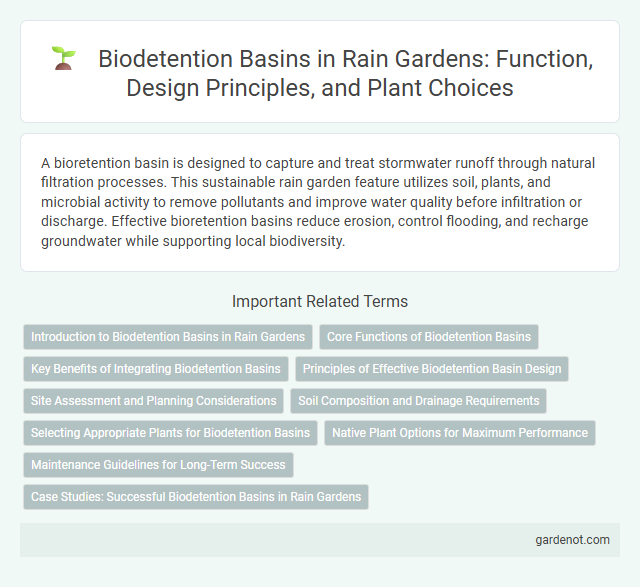A bioretention basin is designed to capture and treat stormwater runoff through natural filtration processes. This sustainable rain garden feature utilizes soil, plants, and microbial activity to remove pollutants and improve water quality before infiltration or discharge. Effective bioretention basins reduce erosion, control flooding, and recharge groundwater while supporting local biodiversity.
Introduction to Biodetention Basins in Rain Gardens
Biodetention basins are engineered rain garden features designed to capture and treat stormwater runoff by mimicking natural hydrologic processes. They enhance water quality by filtering pollutants through vegetation and soil layers while promoting groundwater recharge. These basins effectively reduce urban flooding and improve ecosystem health by slowing down and storing excess rainwater during storm events.
Core Functions of Biodetention Basins
Biodetention basins serve as critical infrastructure for managing stormwater by capturing and temporarily storing runoff, which helps reduce flooding and erosion. These basins facilitate the infiltration of water into the soil, allowing natural filtration processes to remove pollutants such as sediments, nutrients, and heavy metals before they reach waterways. By promoting groundwater recharge and improving water quality, biodetention basins contribute to sustainable urban water management and ecosystem health.
Key Benefits of Integrating Biodetention Basins
Biodetention basins effectively reduce stormwater runoff by capturing and filtering pollutants, improving water quality in nearby ecosystems. These basins enhance groundwater recharge and mitigate localized flooding, promoting sustainable urban drainage. Integrating biodetention basins supports biodiversity by providing vital habitats for native plants and aquatic species.
Principles of Effective Biodetention Basin Design
Biodetention basins function by capturing and slowly infiltrating stormwater runoff, reducing pollutants and mitigating flooding. Key design principles include maximizing surface area for pollutant removal, incorporating vegetation that enhances infiltration and provides habitat, and ensuring sufficient detention time to promote sedimentation and biological uptake. Proper sizing based on watershed characteristics and soil infiltration rates is essential for optimizing water quality treatment and system performance.
Site Assessment and Planning Considerations
Site assessment for a biodetention basin involves evaluating soil permeability, topography, and existing vegetation to ensure optimal water infiltration and storage capacity. Planning considerations must include drainage patterns, proximity to structures, and potential pollutant sources to maximize pollutant removal and prevent flooding. Incorporating native plant species and designing for appropriate retention time enhances the basin's ecological function and stormwater management effectiveness.
Soil Composition and Drainage Requirements
A bioretention basin relies on a carefully engineered soil composition, typically a mix of sand, silt, clay, and organic matter, to optimize water filtration and pollutant removal. The soil must have adequate permeability, often with a hydraulic conductivity between 1x10^-5 and 1x10^-3 cm/s, to ensure efficient drainage without causing standing water. Proper layering and grading prevent saturation while supporting native vegetation, enhancing both stormwater management and ecological benefits.
Selecting Appropriate Plants for Biodetention Basins
Selecting appropriate plants for biodetention basins involves prioritizing native species with high tolerance to fluctuating water levels and variable soil moisture. Plants such as sedges, rushes, and water-tolerant grasses enhance pollutant removal by stabilizing soil and facilitating nutrient uptake. Integrating diverse vegetation with deep root systems improves basin infiltration capacity and supports habitat biodiversity.
Native Plant Options for Maximum Performance
Native plant options such as Carex spp., Juncus effusus, and Asclepias tuberosa thrive in biodetention basins, enhancing water absorption and pollutant filtration. These species support local biodiversity by attracting pollinators and providing habitat while requiring minimal maintenance. Selecting deep-rooted perennials native to the region maximizes soil infiltration and stabilization, ensuring the rain garden functions effectively during heavy rainfall events.
Maintenance Guidelines for Long-Term Success
Regular inspection and removal of accumulated sediment and debris ensure the Biodetention basin functions effectively in managing stormwater runoff. Vegetation maintenance, including pruning and replanting native species, supports pollutant filtration and prevents erosion. Proper maintenance schedules involving seasonal assessments and adaptive practices prolong the basin's infiltration capacity and ecological benefits.
Case Studies: Successful Biodetention Basins in Rain Gardens
Successful bioretention basins in rain gardens demonstrate significant improvements in stormwater management by reducing runoff volume and enhancing groundwater recharge. Case studies highlight installations in urban areas like Portland, Oregon, where integrated rain gardens have decreased pollutant loads such as nitrogen and phosphorus by over 40%. These projects underscore the effectiveness of native vegetation and engineered soil media in optimizing water filtration and supporting sustainable urban landscapes.
Biodetention basin Infographic

 gardenot.com
gardenot.com